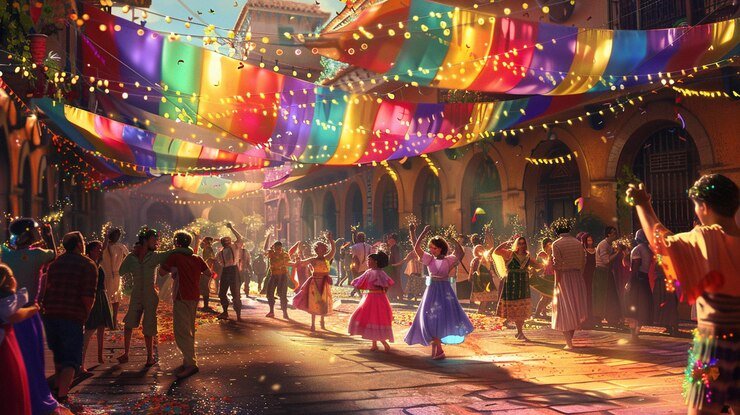
Imagine a city lit by a million lantern a frozen kingdom built entirely of ice or a vibrant street filled with samba dancers and fireworks. These aren’t scenes from movies—they’re real festivals celebrated by millions worldwide.
Festivals are more than just grand events. They are living stories—rich with tradition, joy, history, and human connection. In classrooms and modern learning spaces like the best CBSE schools in Sarjapur Road, these celebrations are woven into lessons, helping children explore new cultures, languages, and global values.
Let’s take a journey through the 10 biggest festivals in the world, uncover their cultural impact, and see how they bring learning to life.
Top 10 Biggest and Most Fascinating Festivals Around the World
1. Carnival – Brazil
The most iconic street festival, Carnival turns Brazil into a canvas of colors, music, and celebration.
- When: February/March
- Why It’s Big: 6 million+ people attend in Rio alone
- Highlights: Dazzling samba parades, extravagant costumes, city-wide revelry
- Educational Value: Teaches performance art, cultural history, and storytelling
2. Chinese New Year – China & Worldwide
Celebrated by over a billion people, Chinese New Year marks new beginnings through tradition and symbolism.
- When: January/February
- Why It’s Big: Global celebrations with 1.5+ billion participants
- Highlights: Dragon dances, red lanterns, lucky food, family reunions
- Learning Link: Great for introducing language proficiency and global traditions
3. Kumbh Mela – India
Recognized as the largest peaceful human gathering, Kumbh Mela is a spiritual festival held on the banks of sacred rivers.
- When: Every 12 years in rotation (Haridwar, Ujjain, Nashik, Prayagraj)
- Why It’s Big: 100 million+ attendees during its largest cycle
- Highlights: Ritual baths, religious processions, spiritual teachings
- Learning Value: Explores Indian mythology, devotion, and community cooperation—common themes in modern education
4. Harbin Ice and Snow Festival – China
An entire city sculpted from ice—Harbin’s winter festival is both artistic and spectacular.
- When: January to February
- Why It’s Big: Millions of global visitors
- Highlights: Gigantic frozen castles, night-light sculptures, snow art
- Learning Value: Introduces students to climate, design, and creative expression
5. Gion Matsuri – Japan
Held in Kyoto for over a thousand years, this traditional festival blends sacred rituals with public celebrations.
- When: July
- Why It’s Big: 1 million+ spectators yearly
- Highlights: Massive wooden floats, kimonos, lanterns, ancient Shinto rituals
- Learning Value: Connects with history, urban design, and ceremonial culture
6. Songkran – Thailand
Thailand’s New Year celebration is also the world’s largest water fight!
- When: April 13–15
- Why It’s Big: Celebrated nationwide with millions joining in
- Highlights: Water splashing, temple offerings, respect for elders
- Learning Value: Combines fun with tradition, cleansing rituals, and renewal
7. Oktoberfest – Germany
Originally a royal wedding celebration, Oktoberfest evolved into the world’s largest beer and folk festival.
- When: September–October
- Why It’s Big: 6 million+ attendees annually
- Highlights: Bavarian music, traditional clothing, cultural pride
- Learning Value: Offers a look into European customs and regional identity in schools like the best IGCSE schools in Bangalore
8. Inti Raymi – Peru
An ancient Incan Sun Festival revived in modern times to honor heritage and nature.
- When: June 24
- Why It’s Big: Huge cultural gathering in Cusco
- Highlights: Ceremonial rituals, indigenous clothing, Incan language and music
- Learning Value: Introduces ancient civilizations and supports importance of reading cultural stories
9. Up Helly Aa – Scotland
A dramatic Viking-themed festival where locals dress in Norse attire and burn a replica longship.
- When: Last Tuesday of January
- Why It’s Big: National participation and historical reenactment
- Highlights: Torch-lit parades, fire ceremonies, Viking storytelling
- Learning Value: A rich example of heritage-based dramatics and historical engagement
10. La Tomatina – Spain
A massive tomato fight held every August in the town of Buñol.
- When: Last Wednesday in August
- Why It’s Big: 20,000+ participants, broadcast globally
- Highlights: 1 hour of tomato throwing, community fun
- Learning Value: Fun introduction to cultural quirks and European celebrations in the best CBSE schools in Bangalore
Festival Fun Facts
- Over 100 tons of tomatoes are used during La Tomatina
- Some floats in Gion Matsuri are so tall, they require city wires to be temporarily removed.
- Kumbh Mela is visible from space and was recognized by UNESCO as an Intangible Cultural Heritage.
Conclusion
The world’s biggest festivals are vibrant, rich, and unforgettable—but they’re also powerful learning experiences. They blend culture, emotion, creativity, and community—everything that great education aspires to nurture.
Incorporating festivals into school learning fosters curiosity, global awareness, and respect for traditions. Whether it’s the icy brilliance of Harbin or the spiritual tide of Kumbh Mela, each festival leaves an imprint that goes beyond celebration—it builds character, understanding, and imagination.
FAQs
1. What is the largest festival in the world?
Kumbh Mela in India holds the record, with over 100 million attendees in a single event.
2. Why should students learn about festivals around the world?
It enhances global awareness, cultural sensitivity, and curiosity—important traits in 21st-century learners.
3. Can festivals be integrated into classroom activities?
Yes! Through art, storytelling, presentations, and even mini cultural days.
4. Which festivals are most fun for kids to learn about?
Songkran, La Tomatina, and Chinese New Year are fun, colorful, and full of exciting stories.
5. How do festivals support holistic education?
They engage the head (knowledge), heart (emotions), and hands (creativity), aligning with whole-child development models.
